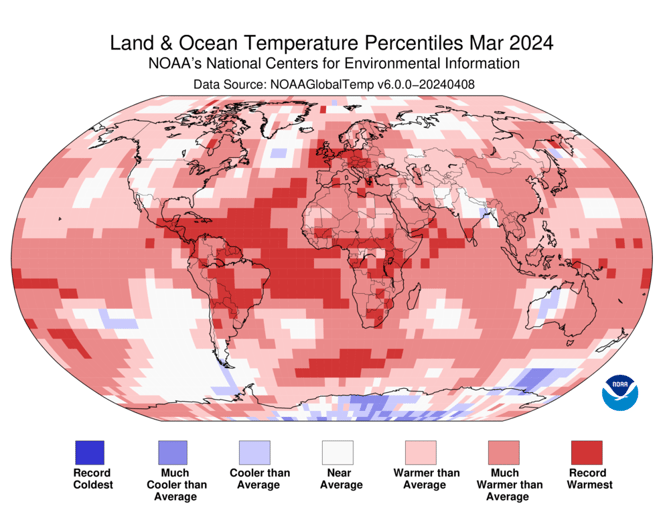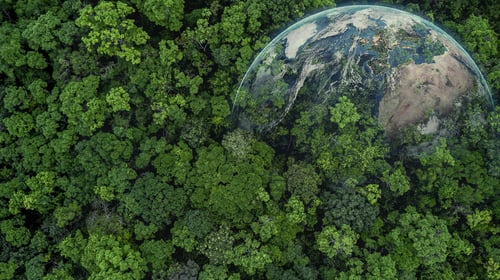As we commemorate Earth Day this year, it's important to confront our planet's harsh realities. Despite the numerous efforts of scientists, activists, and the tech-savvy younger generation, the ecological crisis deepens, underscored by persistent natural resource deterioration and escalating climate challenges. Today, we are driven more than ever to harness innovative technologies, including artificial intelligence (AI), to advance environmental, social, and corporate governance (ESG) initiatives and attain sustainability for a better future.
Learn “How Organizations Are Using NLP To Detect Greenwashing.”
Deteriorating Natural Resources
Over the past decades, our natural reserves have alarmingly diminished. By March 2024, the Earth’s average surface temperature has increased to approximately 54.9°F (12.7°C), a seemingly minor increase that masks significant polar ice melt and accelerated climate change.
 Land and Ocean Temperature Percentiles March 2024. Source: noaa.gov.
Land and Ocean Temperature Percentiles March 2024. Source: noaa.gov.
Greenhouse gas emissions have increased to 37.4 billion metric tons in 2023. According to the United Nations, this is caused by burning fossil fuels, industrialization, food production, over-consumption, and manufacturing.
The loss of biodiversity is growing so fast that we now have around 44,000 species extinct due to climate change, drought, and floods. For example, plastic waste is considered the main contributor to ocean acidification, along with oil and toxins dispensed in the ocean by transportation and shipping companies. Moreover, mass production and mass consumption of food, fast fashion, furniture, and more are, along with urbanism, major factors leading to deforestation and natural resource depletion.
Human Concerns and Environmental Anxiety
These issues not only affect nature but also human well-being. A recent study shows that younger generations face a new form of anxiety called environmental anxiety. It results from their fear of where this crisis leads them and the unclear and ambiguous future. For example, we'll likely suffer from clean water scarcity by 2050, which might produce diseases and epidemics. At this rate, the weather will become hotter, damaging nature and causing massive wildfires. As a result, some areas might become inhabitable, causing mass migration and immigration, resulting in overpopulated cities.
Leveraging AI and ESG for a Sustainable Future
Innovative technologies such as AI are revolutionizing our approach to sustainability. AI tools analyze large amounts of data to monitor ESG metrics effectively, helping organizations to make informed decisions that align with sustainability goals. These technologies facilitate smarter resource management, reduce waste through predictive analytics, and improve energy efficiency. By integrating AI with ESG initiatives, businesses can enhance their operational efficiency and contribute significantly to environmental conservation.
Learn “How Successful Investors Are Using AI to Get ESG Data: A Quick Guide.”
Hope for Change
Despite these daunting challenges, there is room for optimism. From awareness campaigns to employing technology for recycling and reusing resources to building robotic animals to prevent animal captivity, researchers and organizations are doing their best to limit environmental damage. Governments are altering laws and regulations and signing treaties in partnership with active associations and organizations, which are joining efforts to improve life on Earth. Emerging businesses strive to leave an environmental and social footprint by integrating the United Nations' Sustainable Development Goals (SDG) within their corporate culture.
Conclusion
In sum, if we, as a whole, take proper action, the current climate threat could diminish within the next few decades. Helping us get there are more affordable means for renewable energy generation and organic produce and public awareness. We're all capable of making a difference through funding organizations, monitoring our waste and consumption, or participating in local community actions and initiatives. Also, we can learn more about how to help protect wildlife. But NOW is the time to take action to guarantee a better future for us and future generations.
Happy Earth Day!

